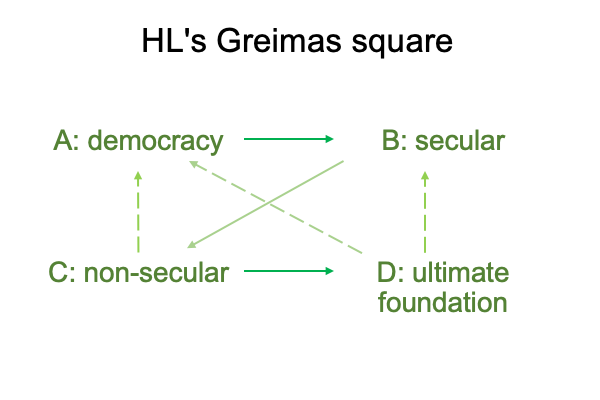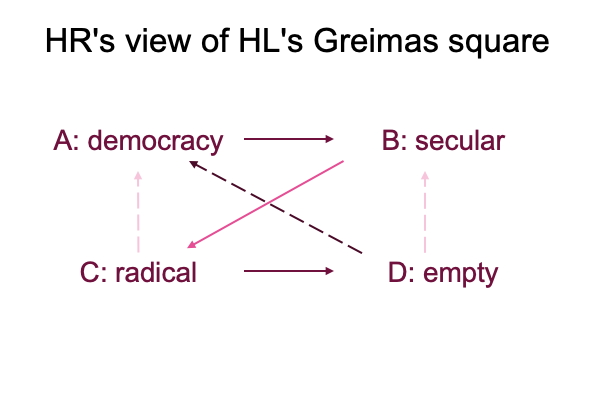Looking at Michael Millerman’s Chapter (2022) “Heidegger, Left and Right” (Part 2 of 2)
0136 Dugin is an example of the Heideggerian Right (HR). HR philosophers are few in number and for good reason. They are considered to be the enemies of the Heideggerian Left (HL), who want to co-opt Heidegger for their theological-political convictions.
Millerman poses this question (more or less), “How does the HL view the theological-political issue of receding secularism and returning religiosity?”
0137 Here is how I associate the discussion to the Greimas square.

0138 According to the HL, A, democracy is under threat because…
0139 …B, democracy must be secular.
Even though secular is an adjective and democracy is a noun and therefore B contrasts with A, secular is a necessary qualifier. A democracy cannot be a democracy unless it is secular. Hence, when HL-friendly pundits on public-private partner television say the word, “democracy”, they actually mean “secular democracy”.
0140 C contradicts B and complements A. C is religious. Non-secular means religious, just as secular means “not religious”. But, this too is wordplay, since religions are not “non-secular”, they are believers in an ultimate foundation, D. However, from the HL Greimas square, C is nonsecular.
At this point, secular institutions take on a scientific glow. The secular (B) use theoretical disciplinary languages to model observations and measurements of social phenomena. Naturally, these models end up defining the options available for ballots in… um… a democracy (A). Thus, the ultimate foundation (D) complements the secular (B) because it (D) does not exist.
0141 D contrasts with C, contradicts A and complements B. Already, I know how D complements B. The fact that an ultimate foundation fills the slot for (D) yet does not exist, according to HL, reveals the nature of the way the ultimate foundation (D) is its own lacking.
Surely, this sounds like a contradiction in terms. But, that is the way HL rolls.
There is no God. There is no ethnos. The possibility that these statements (D) are wrong contradict (A), “democracy”, which, according to HL, must be godless (B). If these statements are incorrect, then the political system would not be a “democracy”, but a “theocracy”.
0142 Okay, HL is into wordplay.
The Heideggerian Right takes the Heideggerian Left’s wordplay at face value, producing the following remake of the HL Greimas square.

0143 As before, A, the focal word, is “democracy”.
0144 B contrasts with A, in the way that an adjective contrasts with a noun. The secret handshake allows HL pundits to indicate a secular democracy when they use the word, “democracy”, and use the word, “theocracy”, when religious folk take to the ballot box.
0145 C contradicts B because the word, “radical” (C), means “rooted”, and “secular” (B) means not religious. This implies that the radical (C) adheres to emptiness (D) with the same conviction that the religious, er… non-secular (C) adheres to an ultimate foundation (D). No wonder the radical (C) strives to eradicate the ontological and theological facets (phenomena) of the narod. The radical (C) creates conditions where other social phenomena (such as the individual, class membership, the roles of citizen and noncitizen) can be observed and measured by modern scientifically minded theoreticians (B).
0146 Emptiness (D) entails the absence of (1) an ultimate foundation encompassing both God and humans, (2) the ethnos, (3) what we evolved to be and (4) the Lebenswelt that we evolved in.
D contrasts with C, contradicts A and complements B.
Emptiness (D) contrasts with radical (C) because it (C) is rooted in ‘something’ (however ephemeral, such as an act of will).
Emptiness (D) contradicts democracy (A) because the implementation of secular policies (B) reveals the root (C) to be a pure act of will, rather than a product of say… philosophical inquiry.
Emptiness (D) complements the secular (B) because the secular knows that its politics will undermine whatever traditions that they are rooted in (C).
0147 In sum, the HL diagram celebrates democracy (A) and the secular (B) while denying the religious (C) and the possibility of an ultimate foundation (D). The HR view of the HL diagram positively labels the negative attitude towards religion as “radical” (C) and the denial of an ultimate foundation (D) as “emptiness”.
0148 To me, the Greimas square for the HL and for what the HR thinks of the HL’s views must be regarded as funny. Perhaps, hilarious.
How so?
The ethnos is where our sense of humor evolves. The narod is where people formulate jokes. The secular is where people lose their sense of humor . Democracy is where the comedy of the humorless plays out on the world stage.
0149 I do not know whether Heidegger’s “fourfold” or “das Geviert” can be re-articulated as a Greimas square. It might be worth trying. Perhaps, use of the Greimas square will allow the HL to take themselves less seriously and the HR to chuckle under their beards. The problem, of course, is that Dugin is no longer laughing, because the ones who take themselves seriously have designated him, not as a philosopher, but as a threat.
Pray for the soul of Alexander Dugin’s daughter.
0150 My thanks to Millerman for his excellent book. Please check out the Millerman School and dugin.com.



















